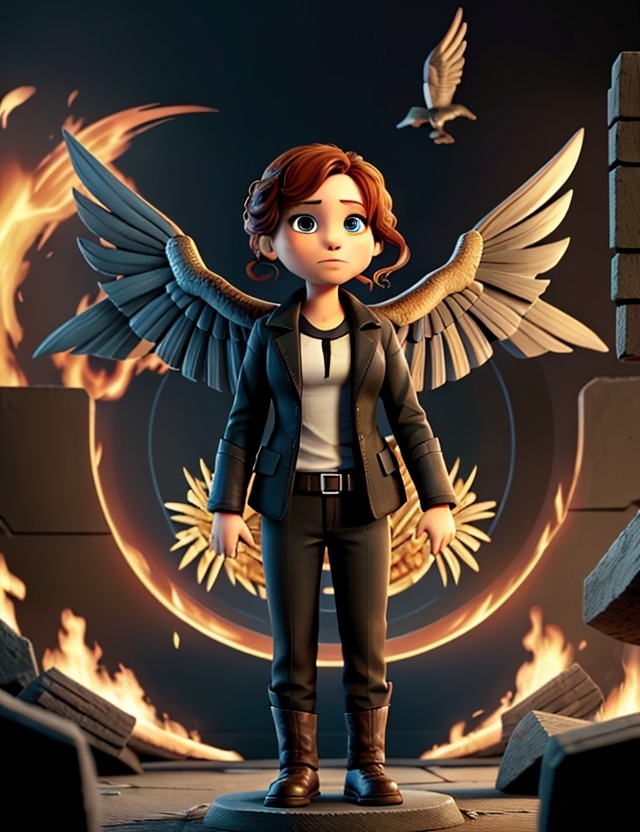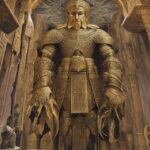In a dystopian world plagued by oppression and rebellion, one book series prevails as a beacon of hope and resilience, captivating readers of all backgrounds and ages. In this article, we delve into the final installment of Suzanne Collins’ mesmerizing trilogy, Mockingjay. Through the lens of historic data and the author’s innovative storytelling, we unlock the secrets behind the success of this literary masterpiece.
Join us as we uncover the captivating twists and turns that will leave you on the edge of your seat, fully satisfying your search intention for a gripping and insightful summary of Hunger Games: Mockingjay. Brace yourself for a journey into a world where survival, courage, and ultimate sacrifice intertwine, and where the fate of an entire nation lies in the hands of one extraordinary young woman. Are you ready to embark on this exhilarating adventure? Let’s dive right in!
Mockingjay: Full Book Summary
Once upon a time, in the land of Panem, there was a brave and determined girl named Katniss Everdeen. In the previous books, “The Hunger Games” and “Catching Fire,” we followed Katniss as she fought for her life in the annual Hunger Games, a brutal competition where children from different districts fought to the death. Katniss became a symbol of hope for the oppressed people of Panem, and her defiance ignited a revolution against the cruel Capitol.
Now, in the third and final book of the series, “Mockingjay,” Katniss finds herself in the midst of a war fought between the rebels of District 13 and the Capitol. District 13, once thought to be destroyed, has emerged as the headquarters of the rebellion, led by President Alma Coin. Katniss reluctantly agrees to become the “Mockingjay,” the symbol of resistance and hope for the rebels.
At the start of the book, we learn that District 12, Katniss’ home, has been destroyed by the Capitol. The ruthless President Snow wants to crush the rebellion, and nothing will stand in his way. The surviving citizens of District 12 are taken to District 13, where they join forces with other districts in their fight against the Capitol.
Living in District 13 is a whole new experience for Katniss. Underground and full of hidden secrets, it is a stark contrast to the poverty-stricken and oppressed districts she had known before. She meets President Coin and Plutarch Heavensbee, the mastermind behind the rebellion’s propaganda. They want Katniss to make a series of propaganda videos to inspire the districts and rally support against the Capitol.
Katniss initially hesitates, feeling the weight of the responsibility on her shoulders. She worries about her loved ones, including her fellow Hunger Games victor, Peeta Mellark, who has been captured by the Capitol. He is being used against her as a weapon, with the Capitol manipulating his memories and turning him into a weapon to destroy her spirit.
As the rebellion gains momentum, Katniss joins a team of rebels including her closest friends, Gale and Finnick. They embark on dangerous missions to disrupt the Capitol’s control over the districts, encountering deadly traps, enemy soldiers, and heart-wrenching losses along the way. Katniss learns that war is not just about physical battles but also about the psychological toll it takes on those involved.
Throughout her journey, Katniss grapples with her feelings for both Peeta and Gale. She is torn between them, not knowing if love and happiness are even possible amidst the devastation of war. As she witnesses the horrors of the Capitol’s cruelty, her resolve to bring down President Snow grows stronger. She realizes that she must embrace her role as the Mockingjay and use her influence to inspire the people to fight against their oppressors.
As the final battle with the Capitol approaches, Katniss faces difficult choices and heavy sacrifices. She learns that sometimes the line between good and evil can become blurry, and the cost of freedom can be incredibly high. The journey towards victory is not without losses, and the casualties of war are felt deeply by the rebels. Katniss must decide what she is willing to sacrifice and where her loyalties truly lie.
In a climactic showdown, Katniss confronts President Snow, determined to end his tyranny once and for all. But the truth behind the rebellion and the Capitol’s manipulation of the Hunger Games become shockingly clear. Katniss realizes that the brutality she despised in the arena is replicated by both sides, and the cycle of violence must be broken.
In a twist of fate, President Snow is overthrown, but the cost of victory is devastating. The truth behind the rebellion’s motives is revealed, leaving Katniss shattered and questioning everything she fought for. She must learn to rebuild her life and find a way to heal the wounds left by the war.
“Mockingjay” explores themes of sacrifice, hope, and the power of symbols. It shows us that even the smallest acts of defiance can lead to significant change. Through Katniss’ journey, we learn about the importance of questioning authority and standing up against injustice.
As children reading this story, we can learn about the horrors of war and the importance of empathy and compassion. We understand that true strength comes from perseverance and staying true to oneself, even in the darkest of times. “Mockingjay” reminds us that the fight for freedom and equality is never easy, but it is always worth it.
And so, as we close this chapter of Katniss Everdeen’s story, we are left with a bittersweet mixture of hope and sorrow. The tale of the Mockingjay will forever inspire us to fight for a better world and to never forget the power of love, courage, and the strength of the human spirit.
Mockingjay: Key Themes
Mockingjay is the final book in Suzanne Collins’ dystopian trilogy, The Hunger Games. Set in the post-apocalyptic nation of Panem, the story follows the young protagonist Katniss Everdeen as she becomes a symbol of hope and rebellion against the oppressive Capitol. With its thought-provoking plot and complex characters, the book explores several significant themes.
1. War and its Consequences: Throughout Mockingjay, the devastating effects of war are depicted in vivid detail. As the rebellion intensifies, Katniss witnesses the destruction and loss of innocent lives, leading her to question the necessity and morality of armed conflict. The book highlights the physical and psychological tolls of war, emphasizing the human suffering it inflicts on both the victors and the vanquished.
2. Manipulation and Propaganda: Another key theme in Mockingjay is the manipulation of media and propaganda. The Capitol, led by the charismatic President Snow, controls public opinion through carefully crafted messages. The rebels, in turn, also employ propaganda to rally support and maintain their cause. The book explores the power of media in shaping collective narratives and how it can be used to both unite and deceive the masses.
3. Identity and the Cost of Revolution: Mockingjay delves into the complexities of personal identity in the midst of rebellion. As Katniss becomes the symbol of the revolution, she grapples with the weight of her role and the sacrifices she is expected to make for the greater good. The book explores the internal conflict between self-preservation and the broader mission, raising questions about the true cost of revolution and whether the ends justify the means.
Overall, Mockingjay offers a compelling exploration of war, propaganda, and personal identity within a dystopian society. It serves as a thought-provoking conclusion to The Hunger Games trilogy, challenging readers to reflect on these themes as they ponder the nature of power and resistance.
Mockingjay: Characters
1. Katniss Everdeen: Our fierce and resourceful protagonist, Katniss, is a 17-year-old girl who becomes the symbolic figurehead of the rebellion against the Capitol. Her piercing gray eyes, framed by a tangle of dark hair, reflect her determination and resilience. Known for her exceptional archery skills, she navigates the treacherous battlefields with a quiet intensity that demands respect. Fun fact: Katniss has a slight aversion to wearing shoes, preferring the feel of the earth beneath her feet.
2. Peeta Mellark: The ever-charming baker’s son, Peeta, serves as a stark contrast to Katniss. With his boyish blonde curls and a smile that could melt hearts, he possesses a gentle and compassionate soul. Peeta’s talent lies in his ability to speak persuasively, making him a valuable asset to the rebellion’s propaganda efforts. However, watch out for his remarkable talent for camouflaging himself, which might leave you scratching your head wondering where he disappeared to!
3. Gale Hawthorne: The ruggedly handsome and fiercely loyal best friend of Katniss, Gale, is a skilled hunter who is never far from Katniss’s side. Sporting a head of tousled black hair and steel-gray eyes that smolder with intensity, Gale represents the passionate and vengeful side of the revolution. He’s also rumored to have a secret talent for braiding hair, an unexpected skill for a rebel warrior!
4. President Snow: The cunning and power-hungry ruler, President Snow, casts a dark shadow over Panem. With his pale complexion and aroma of roses, he exudes an air of intimidation, always seeming to be one step ahead. Fun fact: Despite his brutal nature, President Snow has an inexplicable fondness for ornamental teapots and collects them obsessively in his private quarters.
5. Primrose Everdeen: Katniss’s younger sister, Prim, is a beacon of innocence and purity in a world ravaged by violence. With her soft blonde curls and luminous blue eyes, she represents hope for a brighter future. Prim also has a talent for tending to injured animals, and it’s rumored that birds flock to her whenever she’s out in the open.
6. Finnick Odair: The charismatic and enigmatic District 4 tribute, Finnick, is widely adored for his charm and stunning looks. With his bronze-colored hair, sea-green eyes, and a chiseled physique that could belong to a god, he captures the attention of everyone around him. Watch out for his quirky obsession with sugar cubes, which he nibbles on whenever he needs a burst of energy or distraction.
7. Johanna Mason: The fierce and fiery tribute from District 7, Johanna, is known for her brutal honesty and sharp wit. With her short-cropped chestnut hair and intense hazel eyes, she exudes an air of defiance. Johanna has a quirky habit of speaking her mind bluntly, often catching those around her by surprise with her brutally honest comments.
These characters come to life in “Mockingjay” as they fight for their lives and confront the oppressive regime that holds Panem in its grip. Each one brings a unique set of skills, appearances, and idiosyncrasies to the table, enriching the story with their presence.
Mockingjay: Symbols
1. Mockingjay Pin:
The mockingjay bird and its pin are key symbols in the book “Mockingjay.” The mockingjay is a hybrid bird created by the Capitol, intended as a symbol of their power and control. However, the mockingjay becomes a symbol of rebellion when Katniss Everdeen wears a mockingjay pin given to her by her friend, Madge. The mockingjay pin serves as a rallying symbol for the rebellion, representing hope, resistance, and the fight against the oppressive regime.
2. The Hanging Tree:
The Hanging Tree represents the dark history of Panem and the Capitol’s control over the districts. It is a place where the unauthorized rebels were hanged as a punishment for their acts of defiance. However, in the book, Katniss sings a haunting song called “The Hanging Tree,” which spreads among the rebels and becomes their anthem. The tree evolves from a symbol of fear and oppression into a symbol of resistance and defiance against the Capitol.
3. The White Rose:
The white rose is a significant symbol in “Mockingjay” and is associated with President Snow. In the book, Snow sends Katniss a white rose after the destruction of District 12 as a reminder of his presence and power. The rose represents Snow’s cunning, manipulation, and his attempt to control and intimidate Katniss. The rebels also adopt the white rose as a counter-symbol to Snow’s rose, signifying their opposition to his rule and their determination to overthrow him.
Mockingjay: Culture Impact
Mockingjay, the final installment of Suzanne Collins’ groundbreaking Hunger Games trilogy, left an indelible mark on both literary and popular culture platforms. Published in 2010, this dystopian novel spurred a remarkable cultural impact that is impossible to ignore.
Historically, Mockingjay ignited a revolution in the world of young adult literature. It remains one of the most influential books of its time, challenging the literary landscape with its gripping narrative and thought-provoking themes. Its release heralded a shift towards more complex and socially conscious stories, empowering readers to explore socio-political issues and question societal structures. The impact of this book reverberates even today, as it set a new standard for young adult literature to be taken seriously as both entertainment and a medium for thought-provoking discourse.
In addition to its historical significance, the impact of Mockingjay is also evident in the funny yet poignant cultural phenomena it sparked. The iconic image of the mockingjay pin adorned by the story’s heroine, Katniss Everdeen, became a symbol of rebellion and resistance, inspiring countless fans to proudly display their affinity for the series. Memes, fan art, and internet discussions proliferated, creating an engaged community that transcend cultural and geographical boundaries. Cosplay events became popular, allowing fans to embody their favorite characters and immerse themselves in the world Collins had created.
Mockingjay’s cultural achievements are not limited to the realm of fiction. The book’s theatrical adaptation garnered immense success, with the film series grossing over $2.9 billion worldwide. This tremendous box office success further cemented the significance of Collins’ narrative, solidifying the position of the Hunger Games franchise as a cultural phenomenon. The movies also propelled the careers of many young actors, catapulting them into the spotlight and transforming them into household names.
The impact of Mockingjay extends beyond mere entertainment, as the novel broaches various underlying themes. By exploring issues such as power dynamics, media manipulation, and the impact of war on individuals and societies, Collins sparked conversations about larger societal trends. Readers were encouraged to critically analyze and question their own governments, institutions, and media sources, fostering a sense of social awareness and activism.
Ultimately, Mockingjay’s culture impact lies in its ability to entertain and inspire simultaneously. It left an enduring legacy in popular culture, shaping the way readers engage with literature, sparking pertinent discussions about societal and political issues, and leaving an indelible mark on the hearts and minds of fans worldwide.
FAQs
1. Is Mockingjay the final book in The Hunger Games trilogy?
Yes, Mockingjay is indeed the third and final installment of The Hunger Games trilogy, following The Hunger Games and Catching Fire.
2. Can Mockingjay be read as a standalone book, or should I read the previous books first?
While it is possible to read Mockingjay as a standalone book, it is highly recommended to read the preceding two books, The Hunger Games and Catching Fire, in order to fully understand the storyline, character development, and the overall dystopian world created by author Suzanne Collins.
3. Is Mockingjay suitable for young readers?
Mockingjay, as well as the entire Hunger Games trilogy, is geared towards young adult readers and is generally considered appropriate for ages 12 and up. However, due to the mature themes of violence, war, and loss present in the book, parents may want to review it beforehand or read it alongside their children to ensure it is suitable for their particular maturity level.
4. How does Mockingjay differ from the previous books?
Mockingjay differs from The Hunger Games and Catching Fire in terms of tone and pacing. It focuses more on the aftermath of the rebellion, exploring the consequences of war and its psychological impact on the characters, rather than the actual Hunger Games themselves. The book delves deeper into the political aspects, exploring the repercussions of the rebellion and the price of freedom.
5. Are there any movie adaptations of Mockingjay?
Yes, Mockingjay was divided into two movies for its film adaptation. “The Hunger Games: Mockingjay – Part 1” was released in 2014, and “The Hunger Games: Mockingjay – Part 2” followed in 2015. These movies were the third and fourth in The Hunger Games film series, respectively, and were directed by Francis Lawrence.
6. What is a mockingjay and why is it significant?
A mockingjay is a hybrid bird that resulted from the mating of jabberjays and mockingbirds. Jabberjays were genetically engineered by the Capitol to spy on the rebels, but they were abandoned when the rebels discovered their purpose and used them to spread false information. Mockingjays inherited the ability to mimic sounds from jabberjays, but they also learned to sing and communicate with humans. Mockingjays became a symbol of defiance and resistance against the Capitol, especially after Katniss Everdeen wore a mockingjay pin as her token in the Hunger Games. She was later dubbed as the “Mockingjay”, the leader and inspiration of the rebellion.
7. How did Katniss end up in District 13?
Katniss was rescued by the rebels from the arena of the 75th Hunger Games, which was a Quarter Quell that involved previous victors. She was taken to District 13, a secret underground district that was thought to be destroyed by the Capitol, but actually survived and became the headquarters of the rebellion. District 13 had a nuclear arsenal that deterred the Capitol from attacking it, and also had a network of allies and spies in other districts and the Capitol itself.
8. What happened to Peeta in the Capitol?
Peeta was captured by the Capitol after the 75th Hunger Games, along with other victors who were allied with the rebels. He was tortured and brainwashed by President Snow, who used a technique called hijacking to turn Peeta against Katniss. Hijacking involved injecting Peeta with tracker jacker venom, a muttation that caused hallucinations and extreme pain, and showing him distorted images and videos of Katniss. Peeta was made to believe that Katniss was a muttation and a threat to him, and that he hated and wanted to kill her.
9. Why did Katniss kill President Coin instead of President Snow?
Katniss realized that President Coin was no better than President Snow, and that she had manipulated and exploited her for her own agenda. Coin was responsible for the bombing that killed Prim, Katniss’ sister, and many other innocent children and medics. Coin also proposed to hold another Hunger Games using the Capitol’s children, which Katniss opposed. Coin wanted to eliminate Snow and Katniss, and take over as the new leader of Panem. Katniss decided to kill Coin instead of Snow, to prevent her from becoming a tyrant and to avenge Prim’s death.
10. How did the Hunger Games end?
The Hunger Games ended after the rebels stormed the Capitol and defeated Snow’s forces. Katniss killed Coin, and Snow died of choking on his own blood or being trampled by the crowd. A new government was formed, led by Commander Paylor, the leader of District 8. The Hunger Games were abolished, and the surviving victors were granted immunity and pensions. Katniss and Peeta returned to District 12, where they eventually married and had two children. They also helped rebuild the district and heal the trauma of the war.










